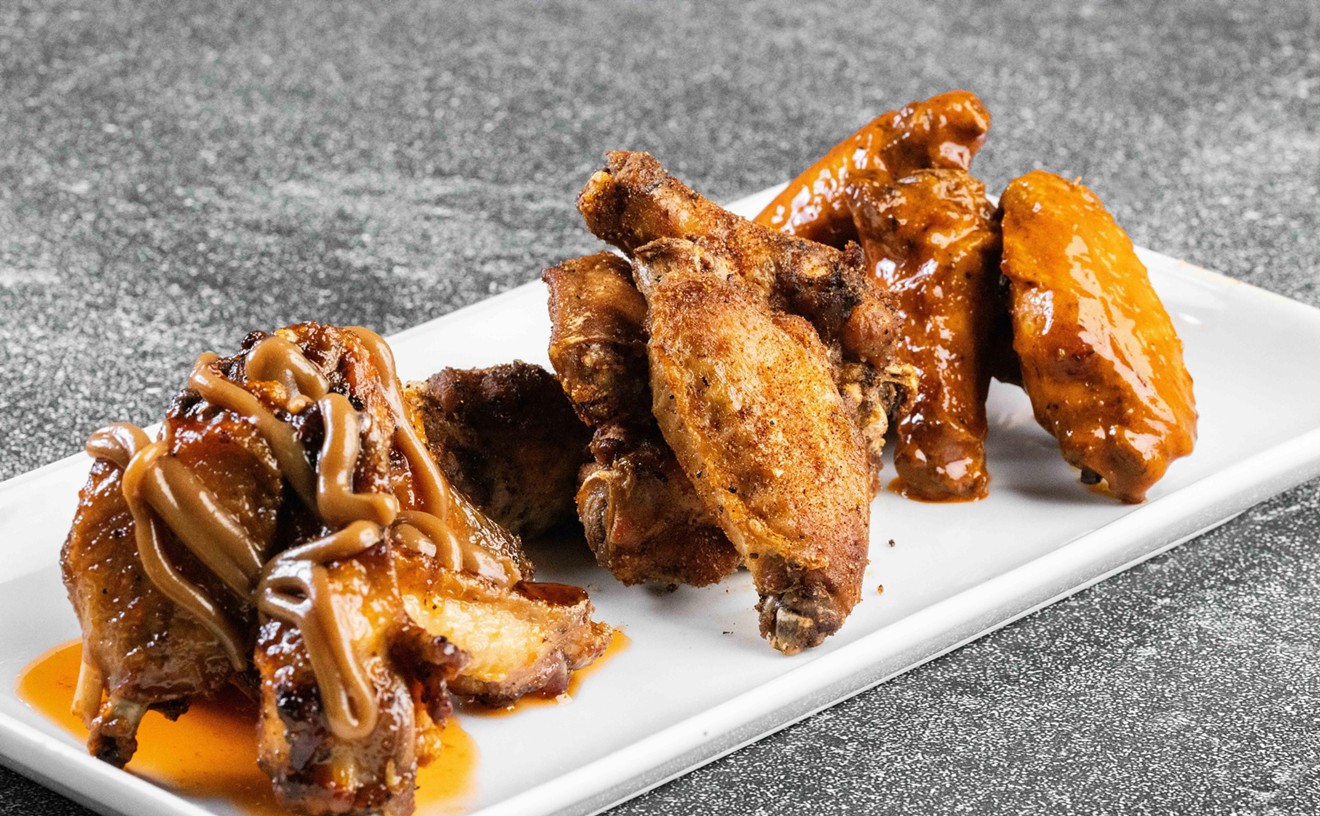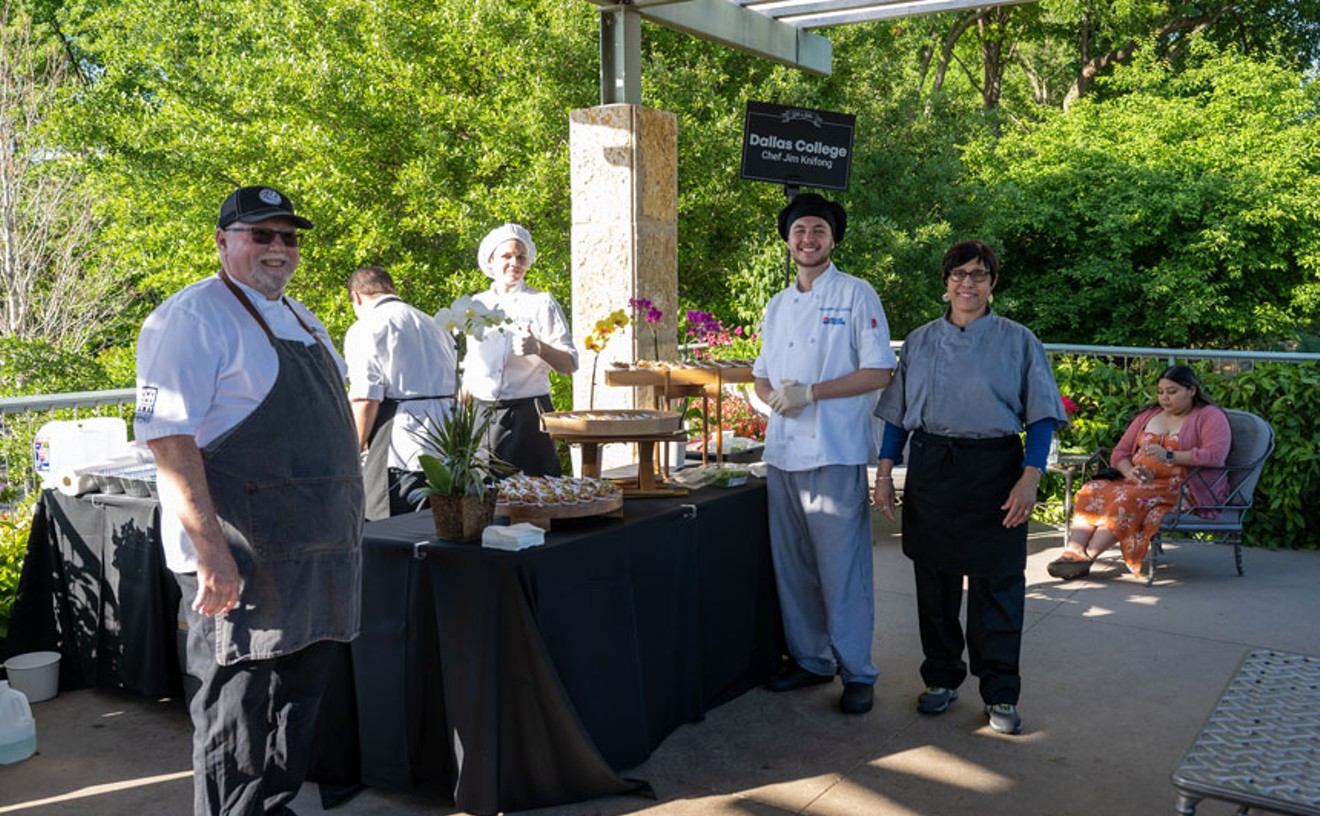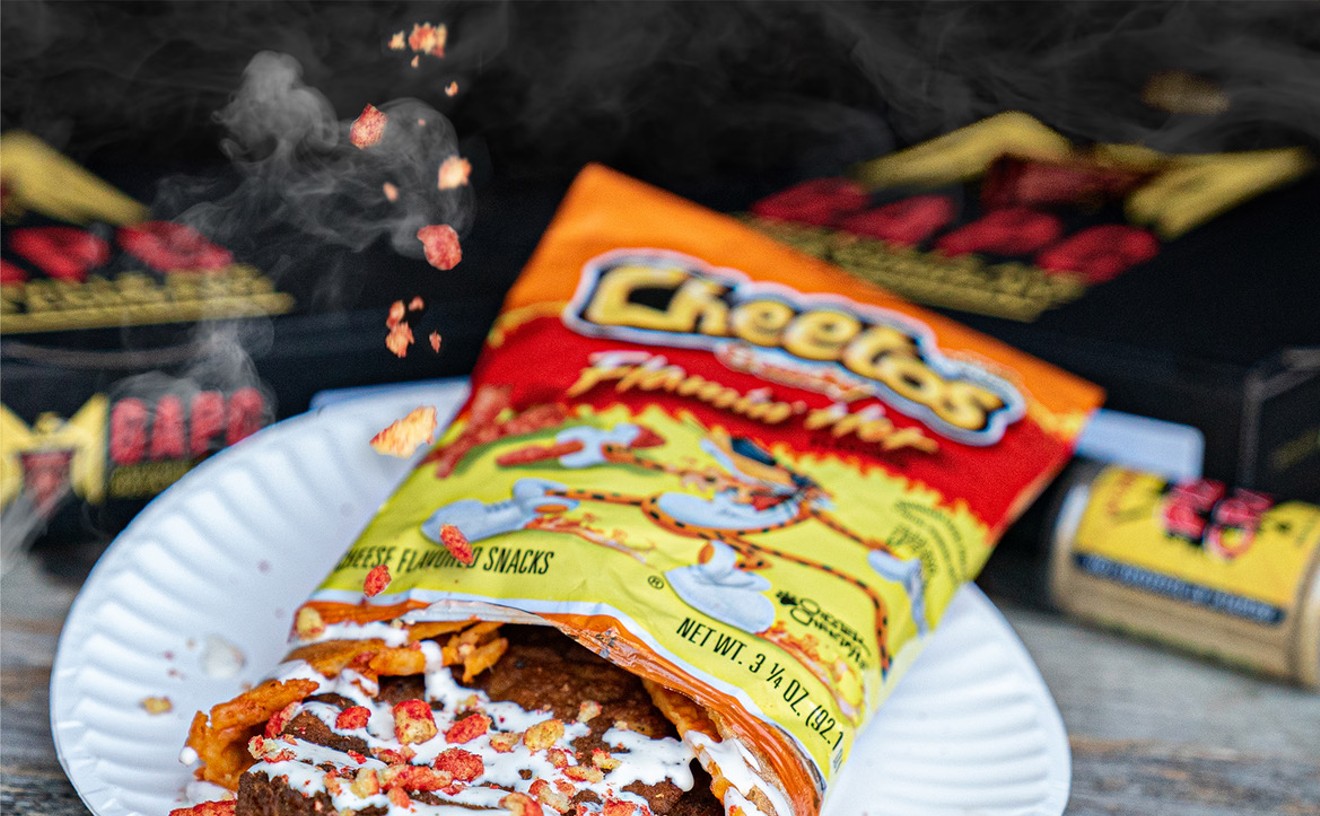Restaurants have fountains, too: fancy trickles, shimmering reflections, gentle cascading drools. Scott Ginsburg's late Voltaire had a stunning black granite water wall several yards long. The defunct Liberty on Lower Greenville Avenue winked at this precious serenity by installing a corrugated washtub filled with koi on the patio. That same space, little bigger than a furnished refrigerator carton, is now Nandina, an Asian tapas bar, but it has been radically altered. The expansive patio that once housed the koi tub has been partially absorbed by the dining room. Plus, a second story has been stapled to the top.
But the most compelling change is that the space stopped winking at "water elements." It now has trickles of earnest tranquility. A massive water wall framed in brushed metal flows near the doorway. A terraced pond with a rush of cascading falls splashes on the patio.
Fountains and other water elements, especially those with tiers, are rooted in strict utilitarianism, according to the Smithsonian Institute. Well before the aestheticism of spurting Neptunes and pissing Davids, fountains were public watering holes where villagers would gather to fill their jugs and hydrate their livestock. Fountains had multiple tiers with higher pools reserved for people and lower ones for livestock.
Perhaps distinct cascading fountain pools are an apt metaphor for a tapas restaurant, where a cavalcade of various plates ends up in the same place. Still it seems forced to stuff Asian culinary culture into the tapas mold, a form of dining rooted in southern Spain. While tapas, or a barrage of little appetizer plates, might resonate in Europe, where traditional meals tend to have entrées orbited by soups, appetizers, palate cleansers, salads and desserts, Asian dining traditions are a little different. For instance, in Japan, from where Nandina draws heavy sustenance, each element can be elevated to centerpiece. This is the case with highly ritualized tea ceremonies, sushi and the deployment of the bento box where each element is meticulously prepared and neatly framed.
Sushi almost relegates the idea of tapas to redundancy. Each piece is a tightly swaddled meal package with starch (rice), vegetable (seaweed, carrot, cucumber, daikon sprouts) and protein (fish, tofu). It even comes with its own palate cleanser (pickled ginger) and condiment (wasabi). These little packets can be mixed and matched to serve as snacks, appetizers or a full meal.
Nandina has fresh, supple sushi. The uni (sea urchin roe) is buttery with edges of briny, tide-pool ripeness. It flaunts a husky yellow tinge resembling a swipe of Dijon mustard or simmered curry. The most expensive uni is red, the next level is orange and the least expensive is yellow. Yet it's often a challenge to discern grades by flavor. I have had mediocre orange servings and sublime yellow ones. Nandina's oozed feng shui, if cuisine can possess such a thing.
The rest had the same level of meticulousness. The spicy tuna roll is often a drab, carelessly assembled thing with nearly indistinct layers and creepy-looking tuna cores (the gray dots centering most grocery-store deli offerings seem primed for fuzz growth). Nandina's, however, has distinct layers and flavors, packed tightly around the bright pink, supple tuna nuclei.
This suppleness carried over to the tuna tartare, a silky web of chopped fish fashioned not in the shape of a mound, as is the habit of the steak variety, but a cylinder. The bright pink, coarsely chopped tuna rested on a reservoir of guacamole.
Such offbeat meldings aren't surprising. Nandina's menu is the work of Seiji Wakabayashi, founder of the "nouvelle Japanese" restaurant Waka in North Dallas and a partner in Nandina. And he has siphoned some of his Waka stuff into Nandina's tanks, including the miso-marinated Kobe beef and a salad of various seaweed species folded with baby terrestrial greens and chives lapped with ginger vinaigrette. The beef was out of stock on each of our visits.
Wakabayashi shares ownership with Kathy and Angie Praxaybane of the Thai restaurant River Spice, and the fare is billed as Japanese and Thai cuisine "in small plate fashion."
Wakabayashi's classical French training soaks through here and there. Lamb chops, orphans in most Asian cuisines, were served with bone tips propped up over a pool of wasabi port wine sauce and a mound of stiff mashed potatoes greened with spinach. The chops were chewy, the firmness giving spine to the rosy silk succulence that all too often descends into a gooey gore of flaccid red in lesser hands. And wasabi is a weird but wonderful way to kick an old port.
Fruit aromas were intense and forward in the crispy quail in plum wine sauce. Passing the plate under the nose was like punching your schnoz into the bowl of a Bordeaux glass after a vigorous, aerating swirl. The quail, split and propped like the lamb, was black in the restaurant's dim, rich amber light. The meat was clean, chewy and moist without those distracting chicken liver flavors that signal a lack of freshness.
Thai touches are minimal, emerging unmistakably only in satay, coconut soup and pad Thai. (From out of India comes a ground chicken-stuffed golden samosa.) Pad Thai is among the best you'll find in Dallas with separate perfectly boiled noodles, a sauce that skirts unction and a throng of shrimp, scallops and squid, all rife with sweet sea flavor.
Even Chinese peeks through in dumplings created from Wakabayashi's training in Chinese cookery (lettuce wraps don't count as they are to Chinese what ham-and-pineapple pizza is to Italian). The dumplings look like little crowns, supple pork and shrimp pouches arranged around a plate with bright red dots of pepper sauce. The inventive part is the dipping sauce: a watery pool of mushroom and soy that lends a little salty earth to the starch.
Nandina, named after a plant known as sacred bamboo, is a flashy clash when boiled down, but it turns out all right. Just about anything can if the wild imagination that animates it is tempered by crisp discipline.
5631 Alta Ave. at Lowest Greenville, 214-826-6300. Open for lunch 11 a.m.-3 p.m. Monday-Friday; open for dinner 5 p.m.-11 p.m. Monday-Friday. Open 11 a.m.-midnight Saturday. $$$










